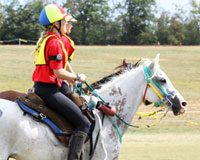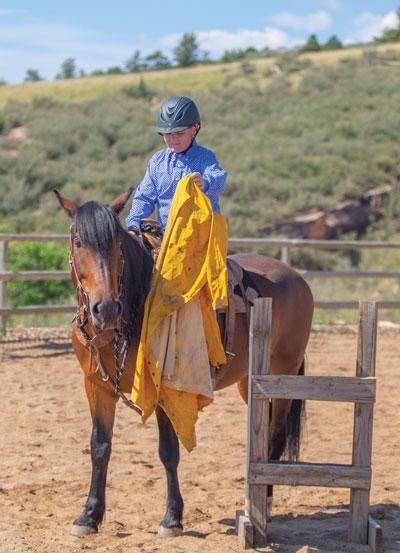
Will your horse allow you to pick up and swing a rain slicker? The noise and fast-moving fabric on both sides of his body can be spook-inducing. Whether you’re preparing for a trail class that includes the slicker as an obstacle or you need to make sure that you can don your jacket without dismounting during a trail ride, you’ll want to know that your horse is relaxed with the slicker’s sound and movement.
Before you get started, outfit your horse with a rope halter and long training lead and have your saddle and bridle ready.
Ground Work with a Rain Slicker
Confirm that your horse feels OK with the slicker moving near and around him before you ride with the jacket. While you work from the ground, you’ll be able to see any reactions—whether he steps away, tenses or just stands still and relaxes.
Start by taking the slicker from a post in the middle of the arena. Make sure you have plenty of space to work, so that your horse doesn’t feel “trapped” next to a fence.
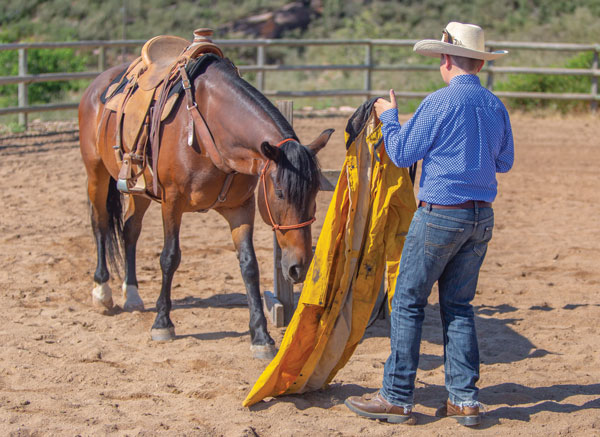
Follow Me
Ask your horse to move forward from the halter and lead pressure while fol-lowing you with the slicker. Following an object helps him think of it differ-ently than a predator he must escape. You want your horse to look interested in the slicker, looking at and sniffing it. Let him take in the information.
If your horse is calm with this step, approach him from one side and then the other. Make sure not to stand in front of your horse as you approach his shoulder and side. Allow him to see the slicker and notice his body cues. Note: Be careful not to get too close. You don’t want to be close enough to get kicked.
If your horse seems calm or simply attentive, progress to swinging the slicker around his side, legs and over him. Move slowly. If your horse seems accepting, ask him to move around you in a small circle. Keep the slicker moving beside him, then eventually on him as he moves. Your horse may act differently as something moves while he’s moving.
If at any time your horse tenses, stop and rebuild your horse’s con-fidence by releasing pressure and speaking softly. You are applying mental pressure as you move and touch him with the slicker. Then you’ll help him relax if you stop when he tenses. If your horse is just learning about the slicker, stopping the movement and stimuli before he has a reaction can build his con-fidence. Once he has paused and relaxed, put pressure on again by approaching him with the slicker in the same way that was once daunt-ing. Let him know the slicker isn’t a constantly scary item.
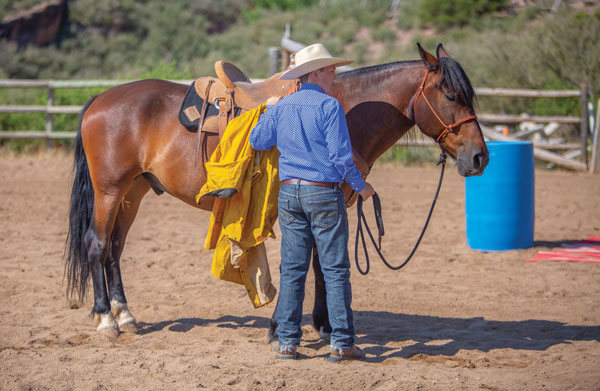
Why stop when you see tension? Many horse owners worry that “you teach what you release.” With this idea, you can’t stop the pressure if the horse is tense or reacting and can only take away pressure if he relaxes. While this can work, the technique isn’t needed in all cases.
In the beginning stages, it’s best to build your horse’s confidence and work to avoid a big spook by stopping the scary experience when you see ten-sion. If your horse reacts in a big way, face your horse, lift up and to the side with your lead rope. This cues your horse to yield his hindquarters. Your horse’s back legs will cross, which slows him and helps him relax. You’ll teach your horse that if he yields his hindquarters, the scary thing will stop.
Saddle Time
If your horse is calm as he follows the slicker and allows the slicker to touch him all over, you’re ready to repeat the steps from the saddle.
Allow your horse to look at the slicker before you pick it up. To start, touch his neck and sides with it. If your horse seems concerned or tenses at any step, stop, calm him, then try again. You can also cue your horse to yield his hindquarters as you ride in a now-familiar response of yielding, then calming.
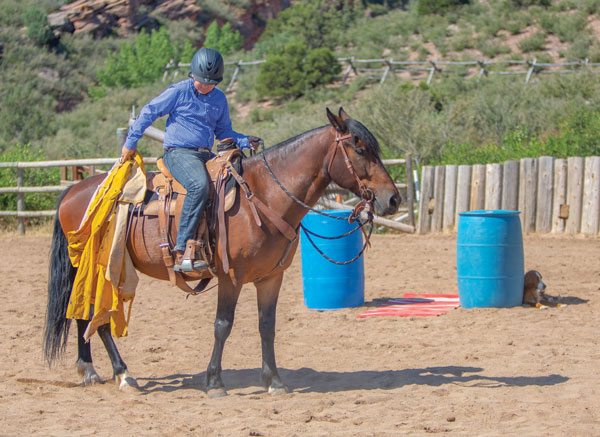
If your horse accepts the slicker touching his sides, legs and hindquar-ters, swing the slicker around as you would to put it on. If at any point you feel that your horse is too tense, dis-mount and move the slicker in the same way while working from the ground.
When you break down the steps and work slowly and diligently, you’ll teach your horse to accept the noise and movement of the slicker no matter where you stand or sit.
Special thanks to Preston Sander-Ferracane and Bravo for assistance with these photos.
This interview about introducing a horse to a rain slicker appeared in the January/February 2020 issue of Young Rider magazine. Click here to subscribe!




